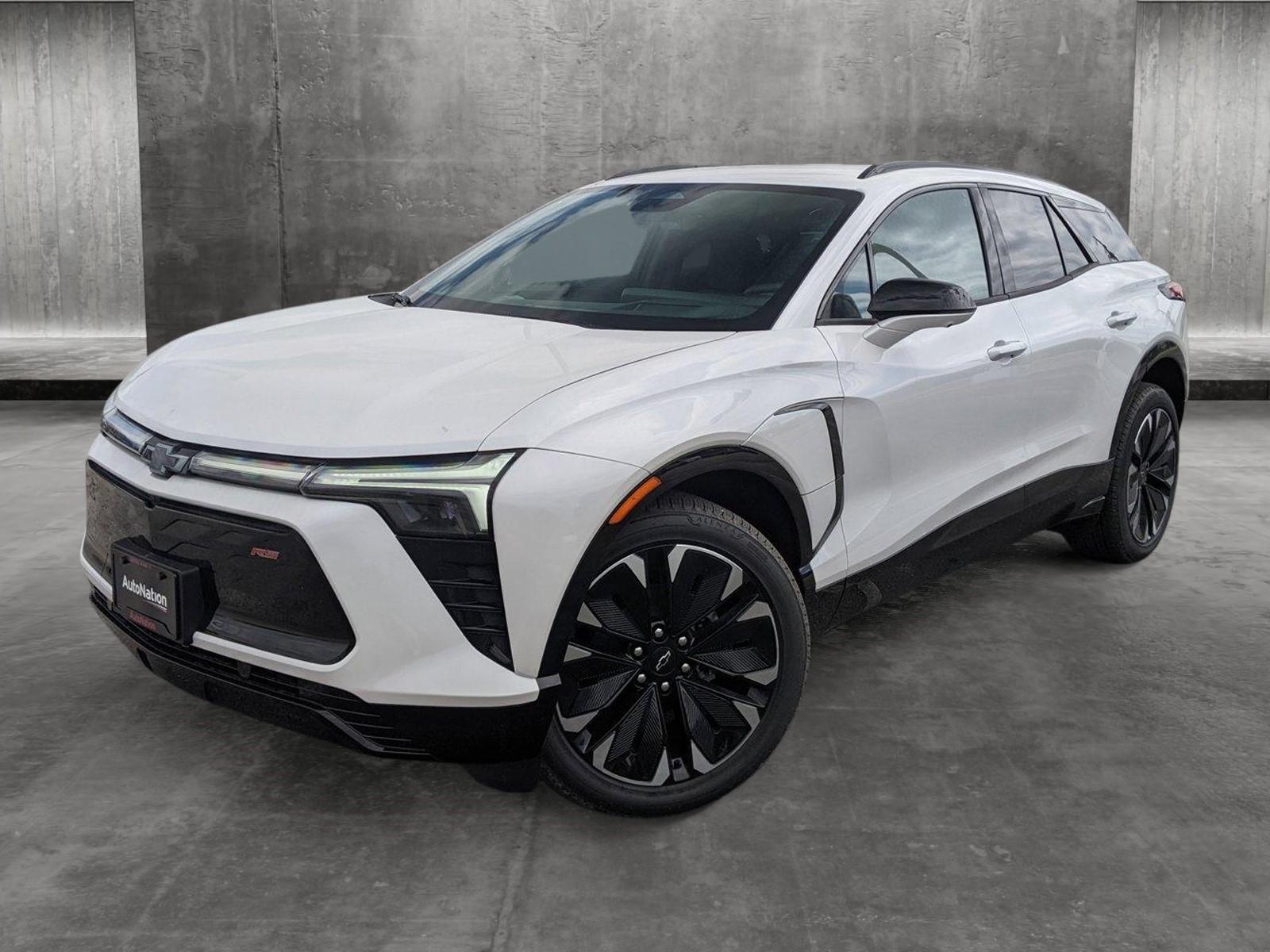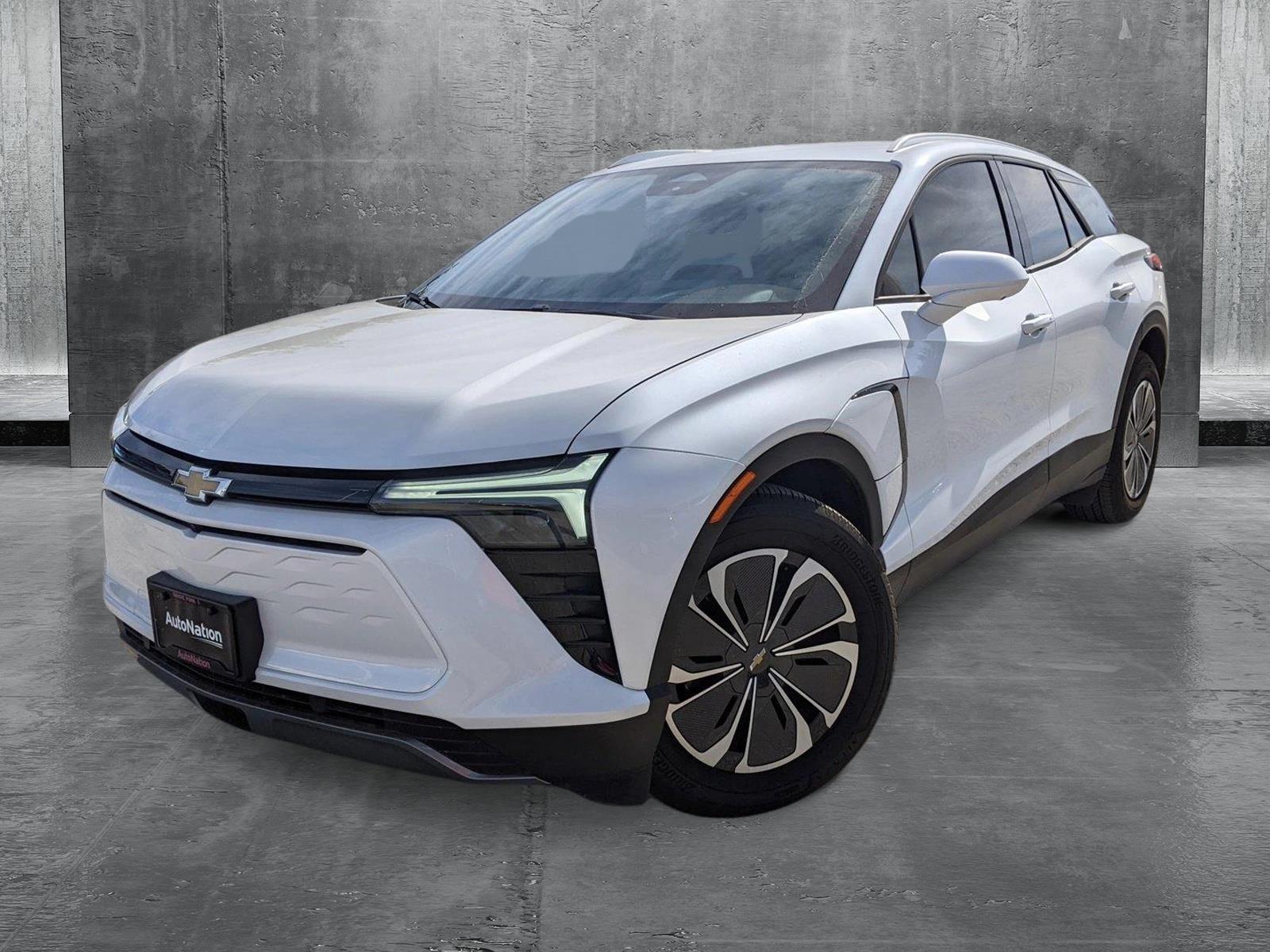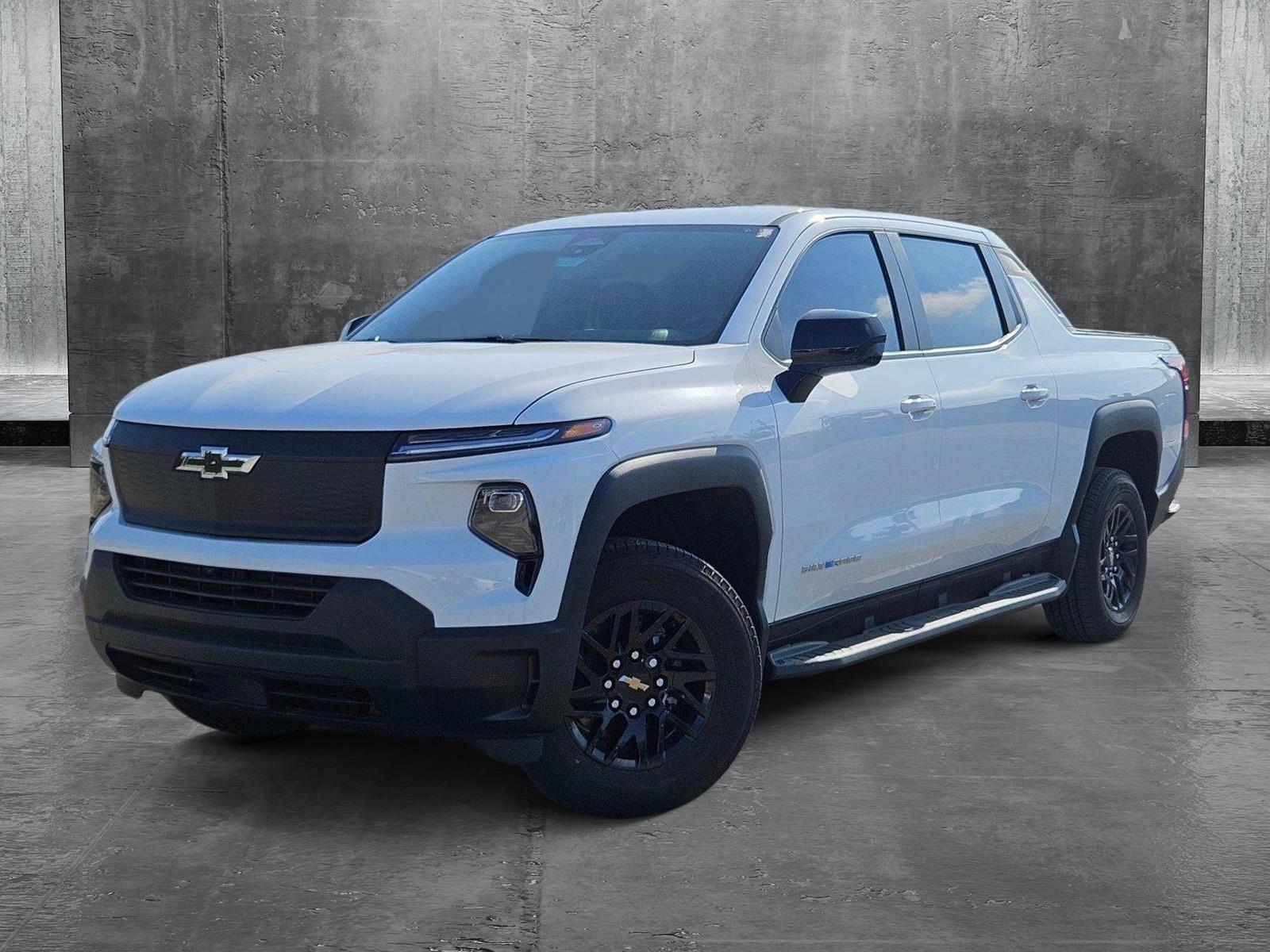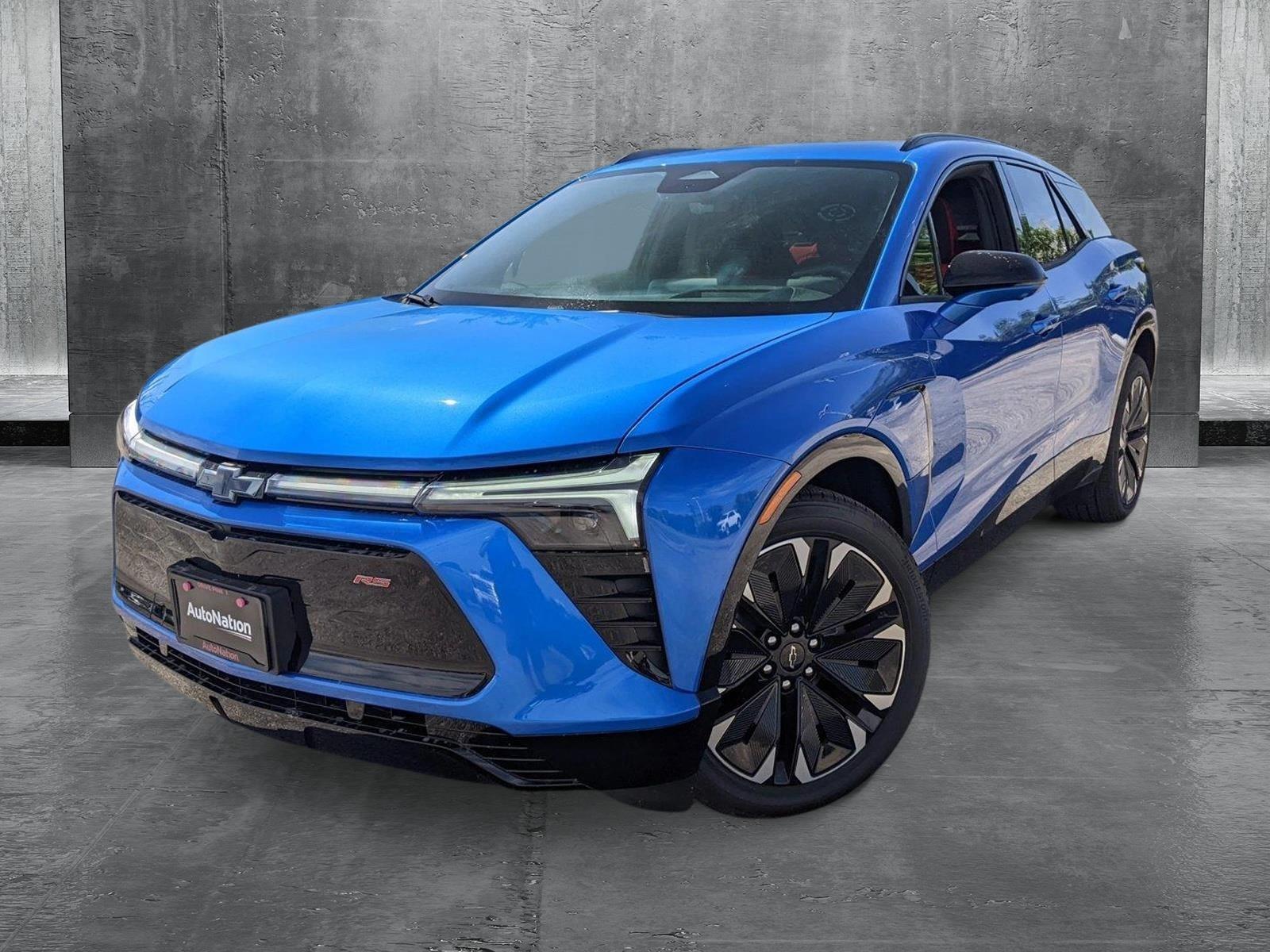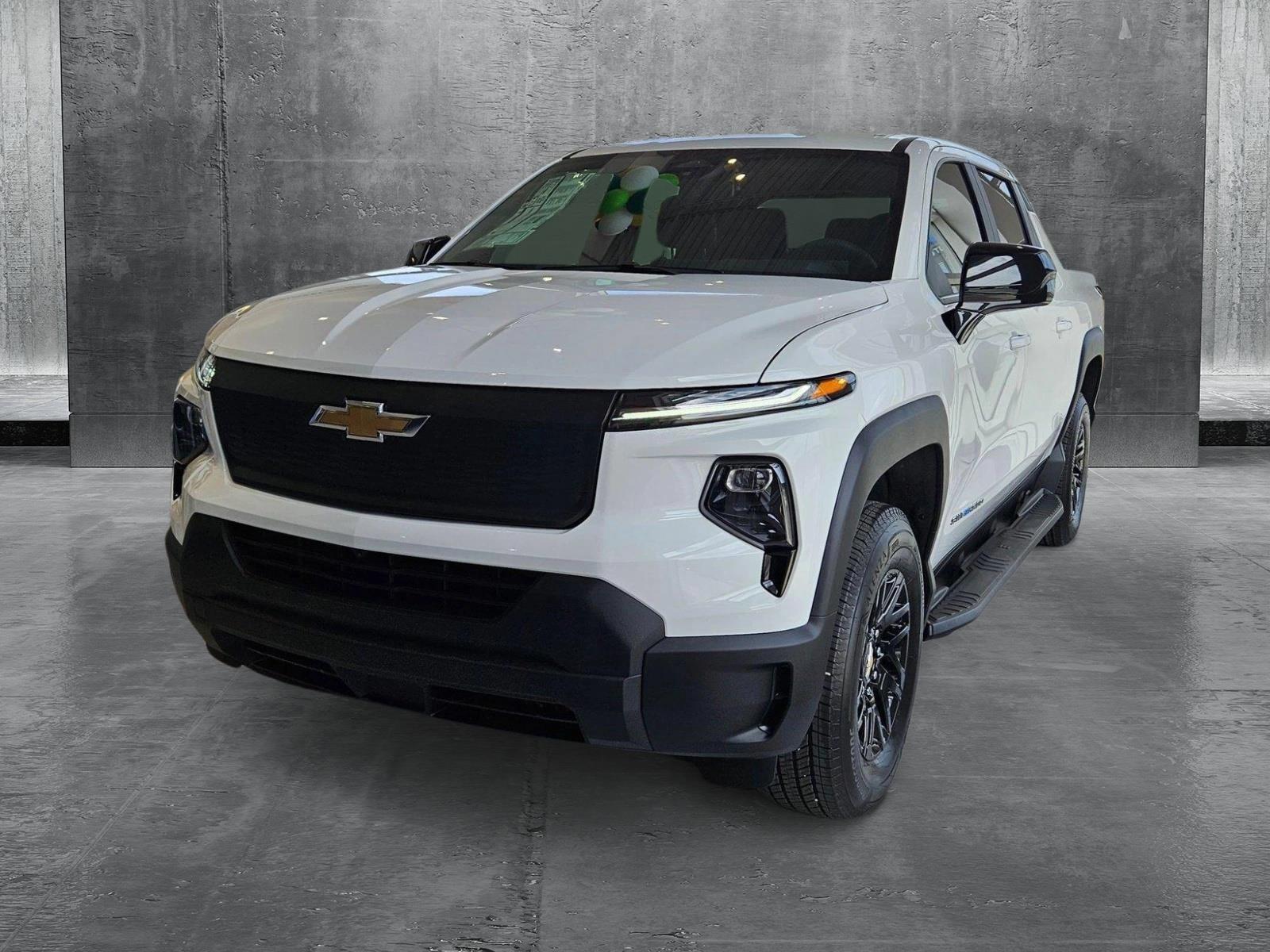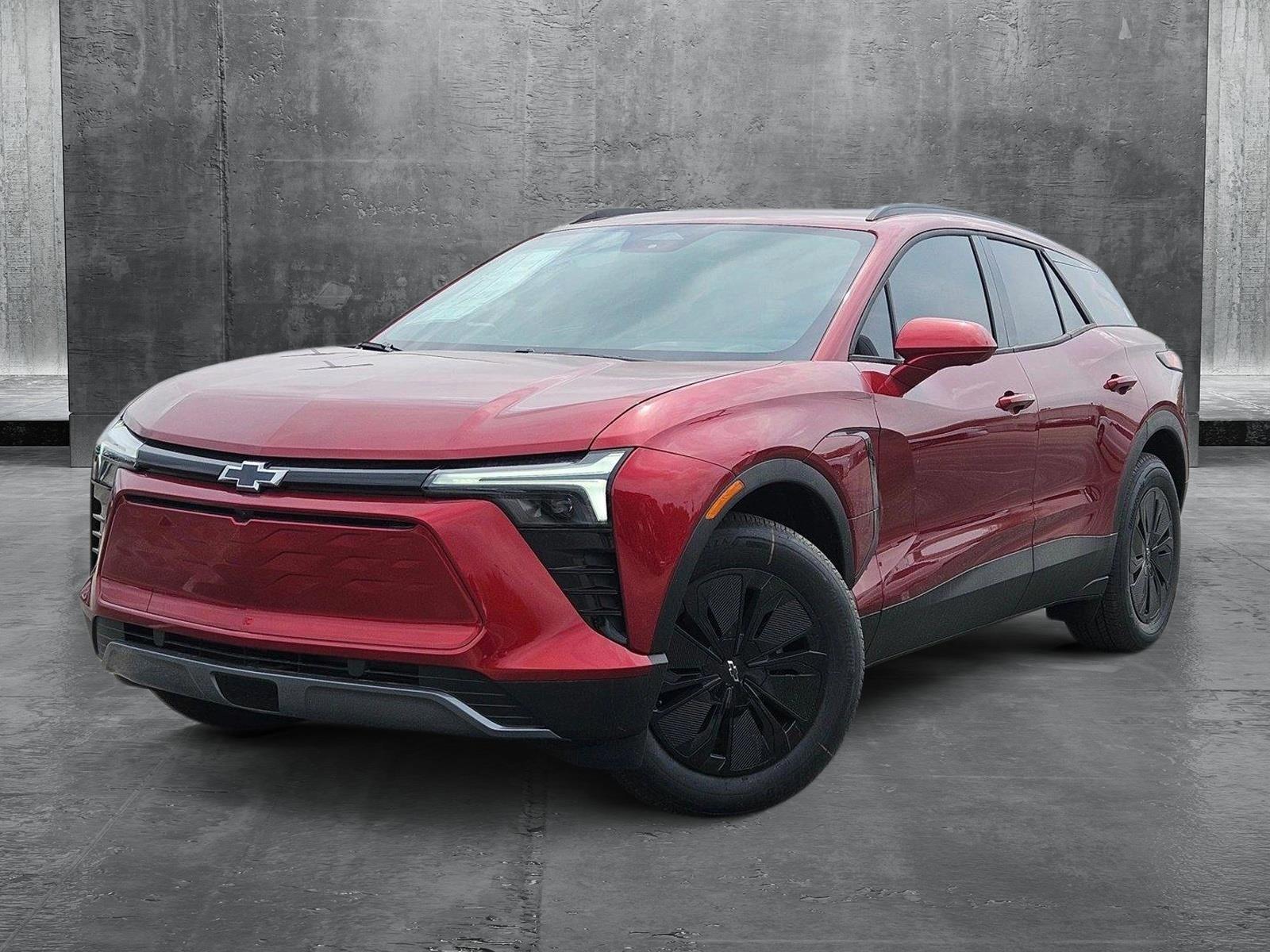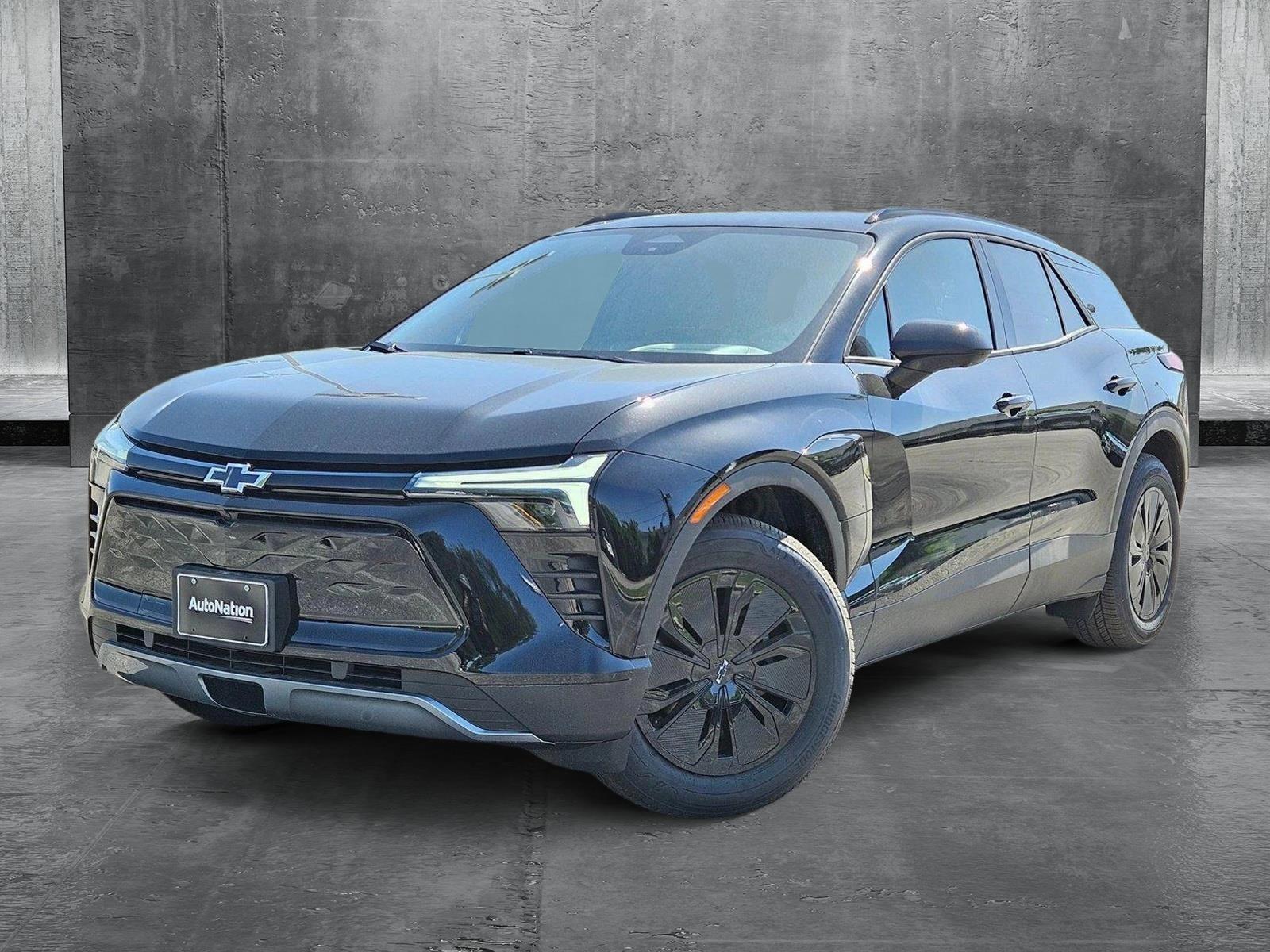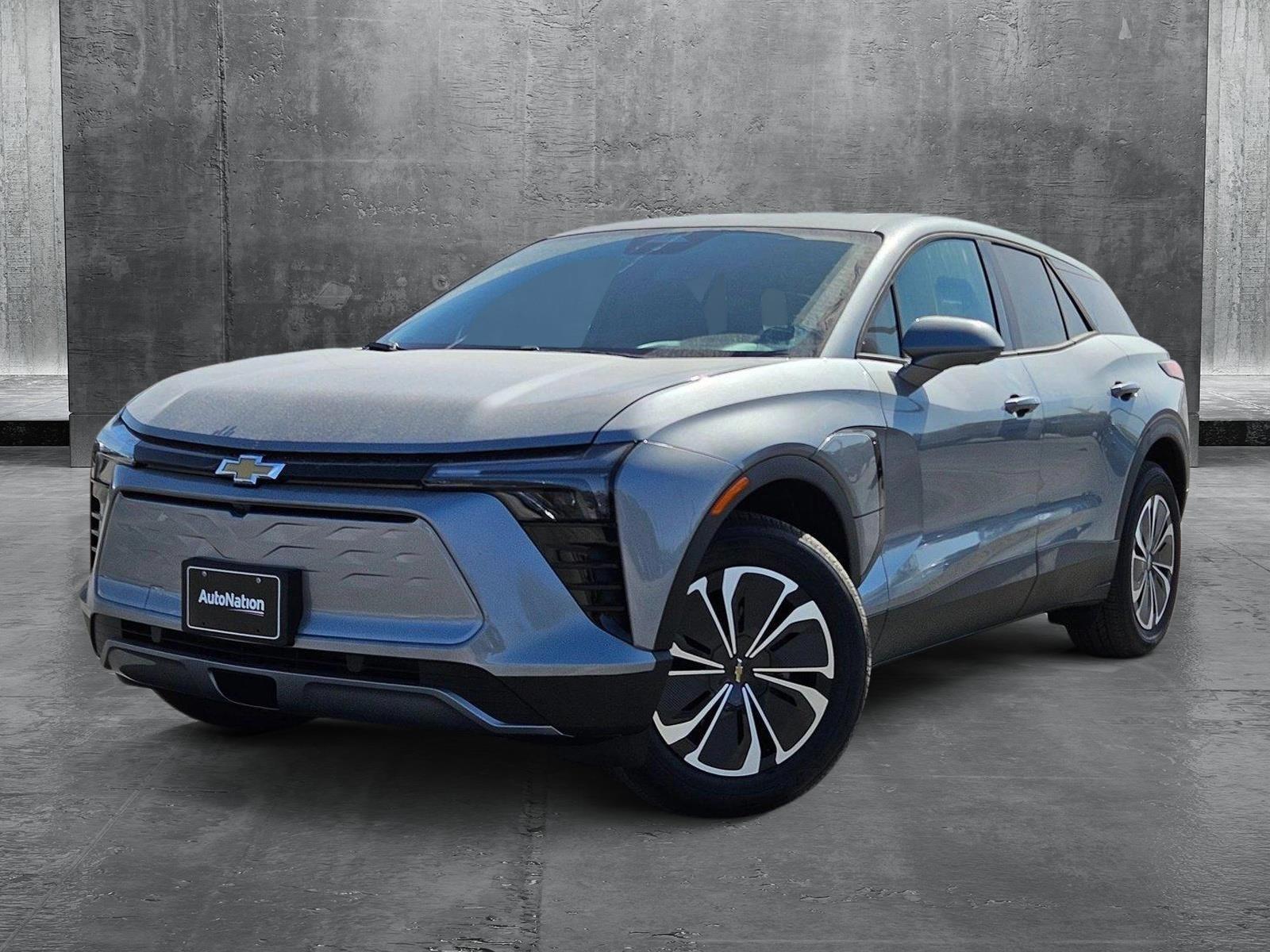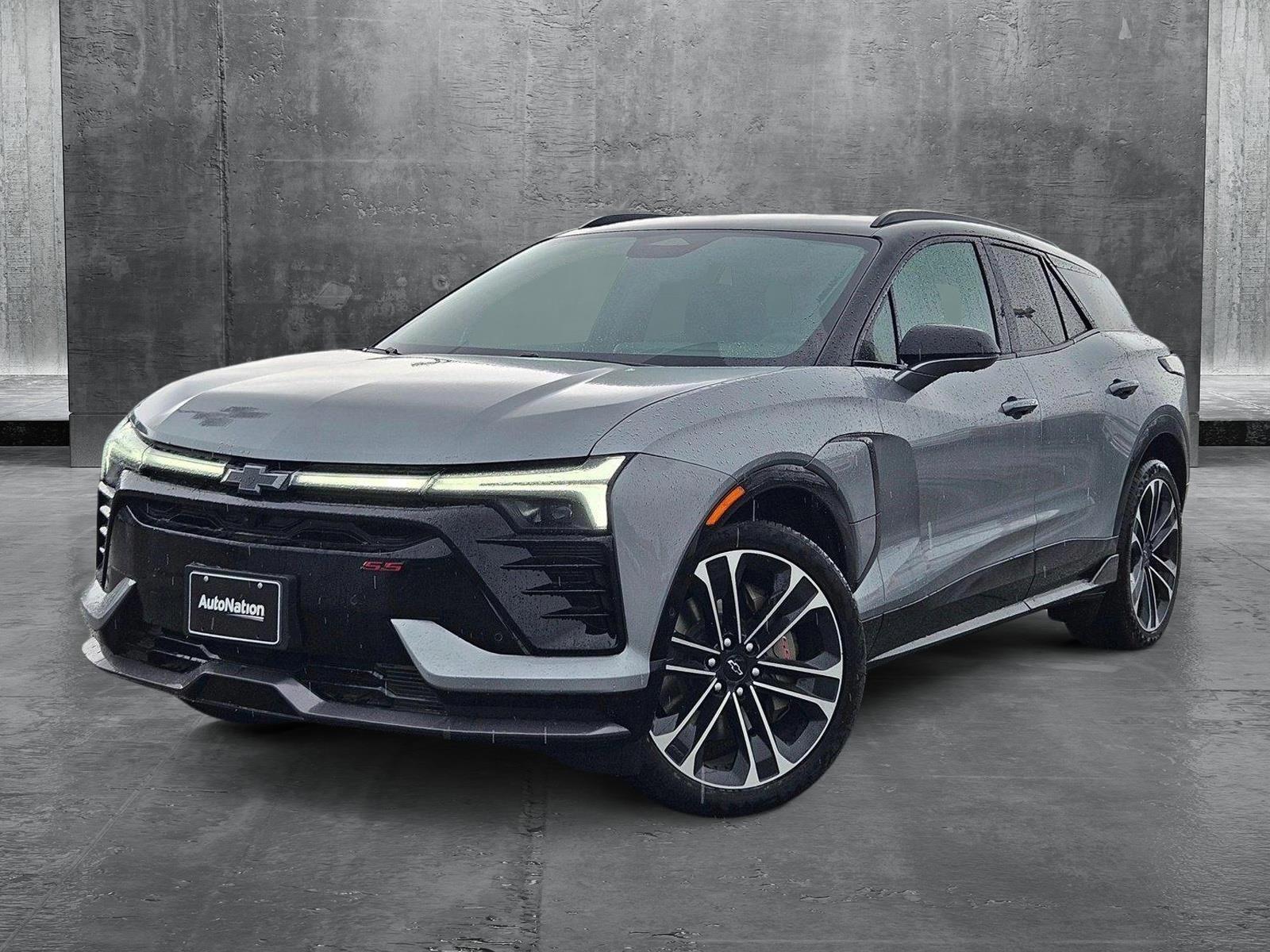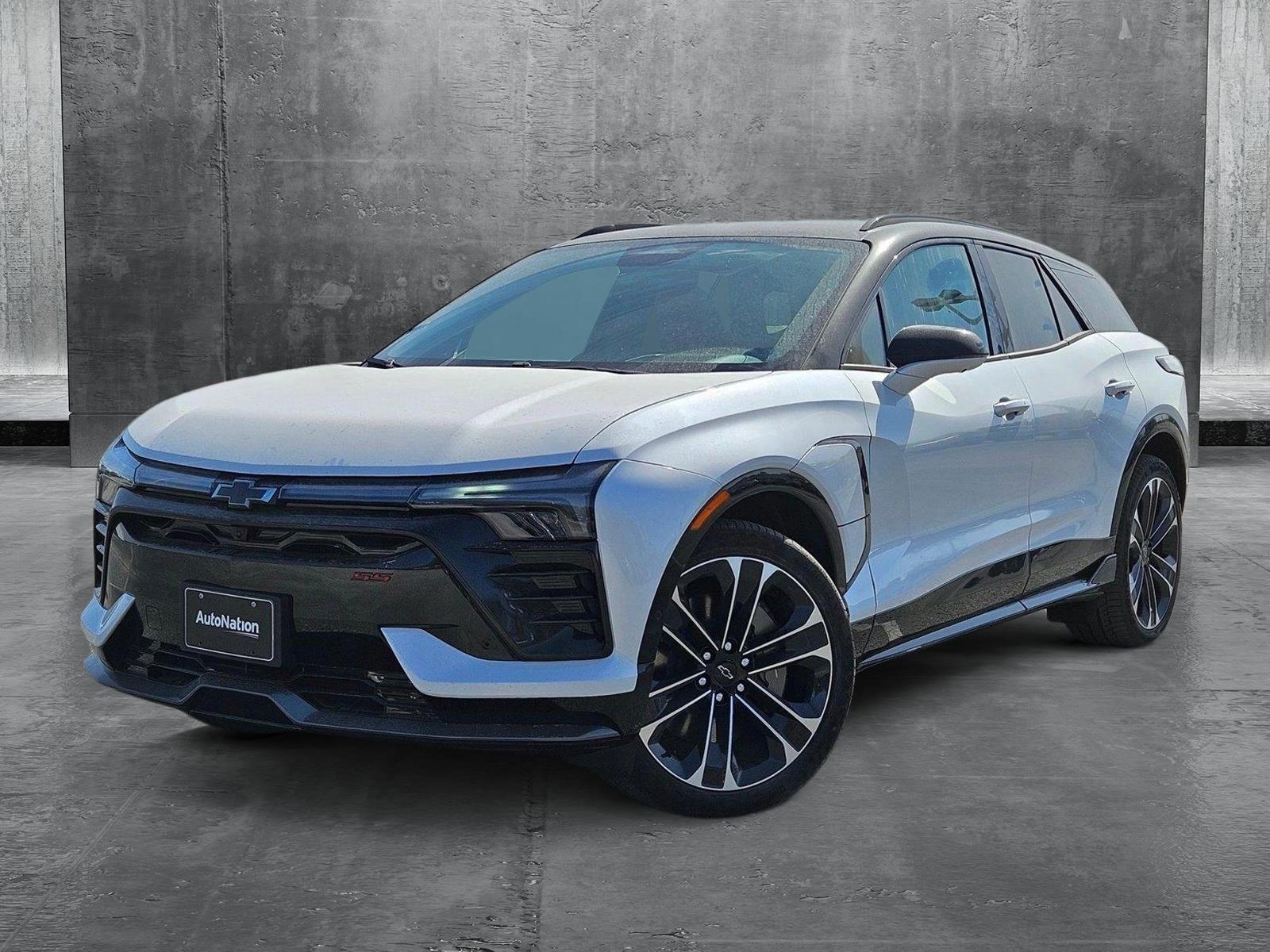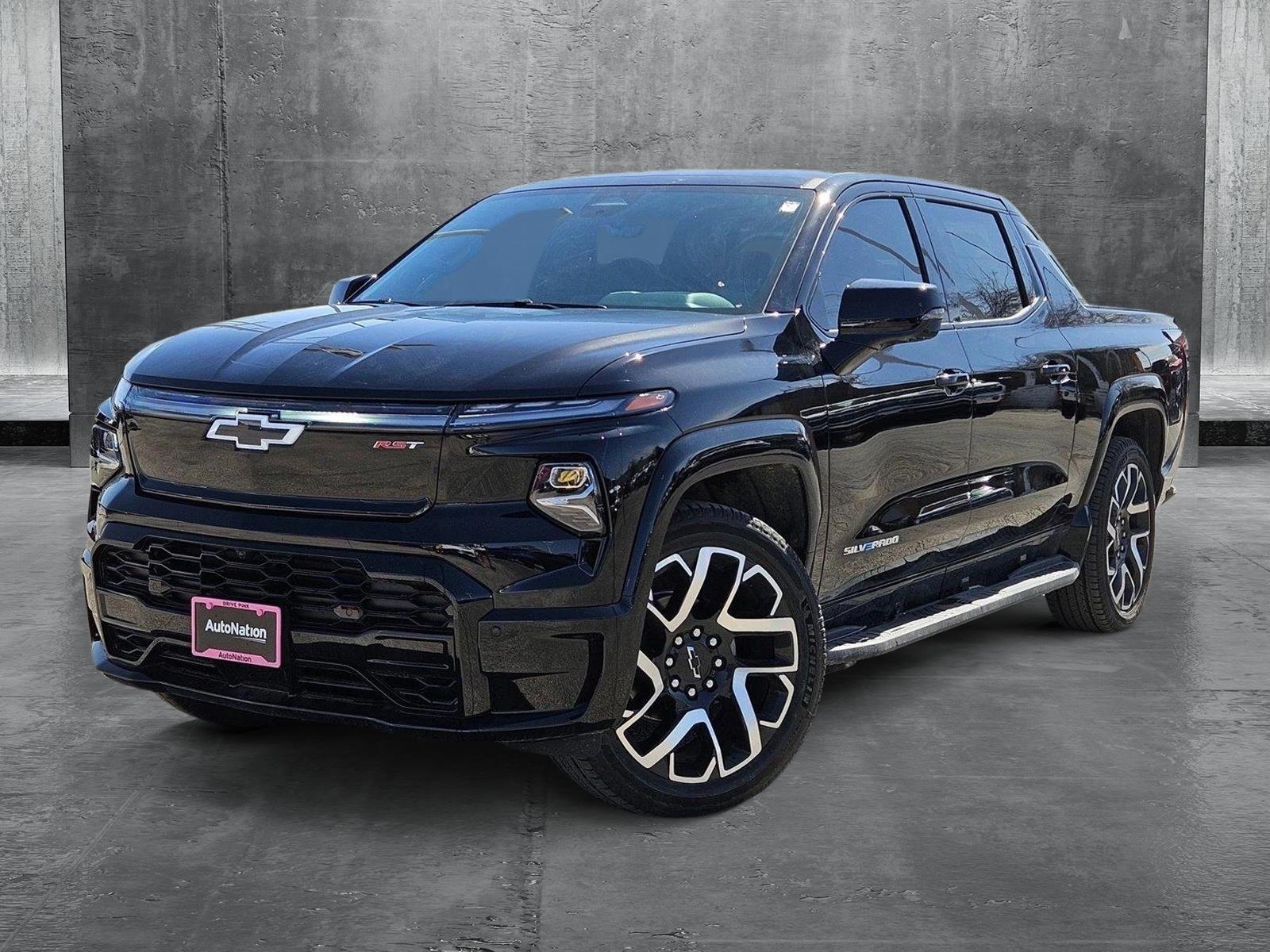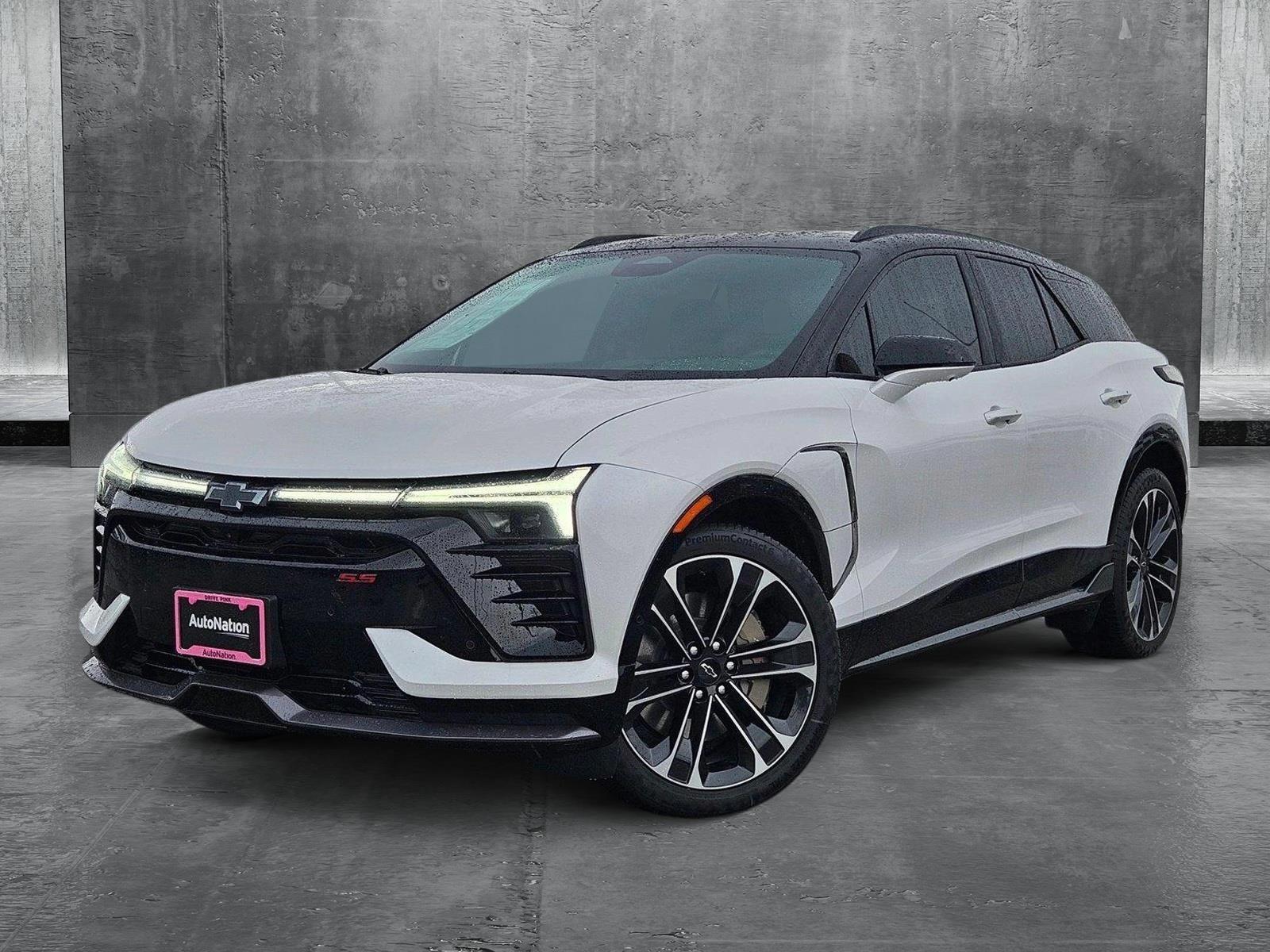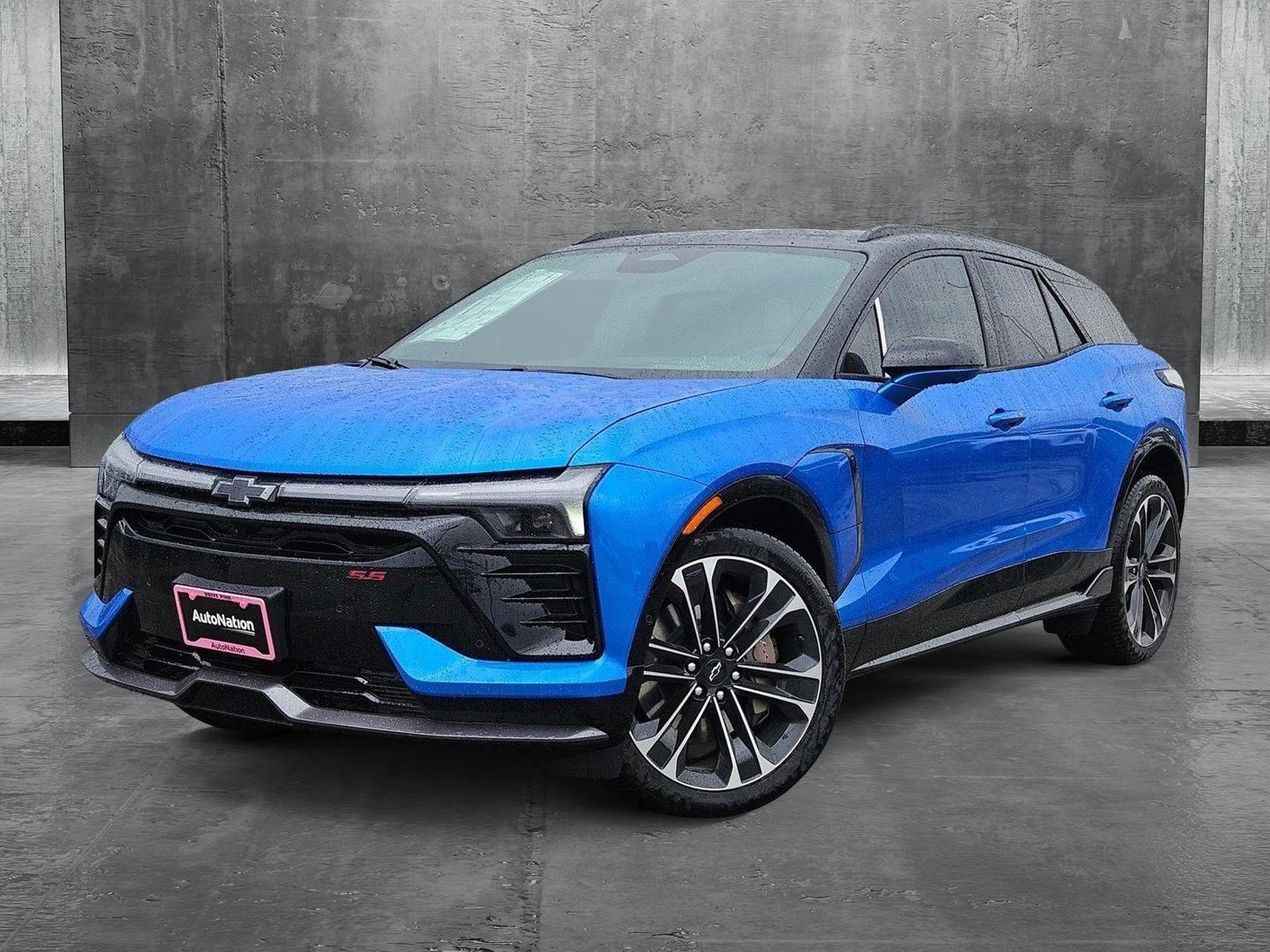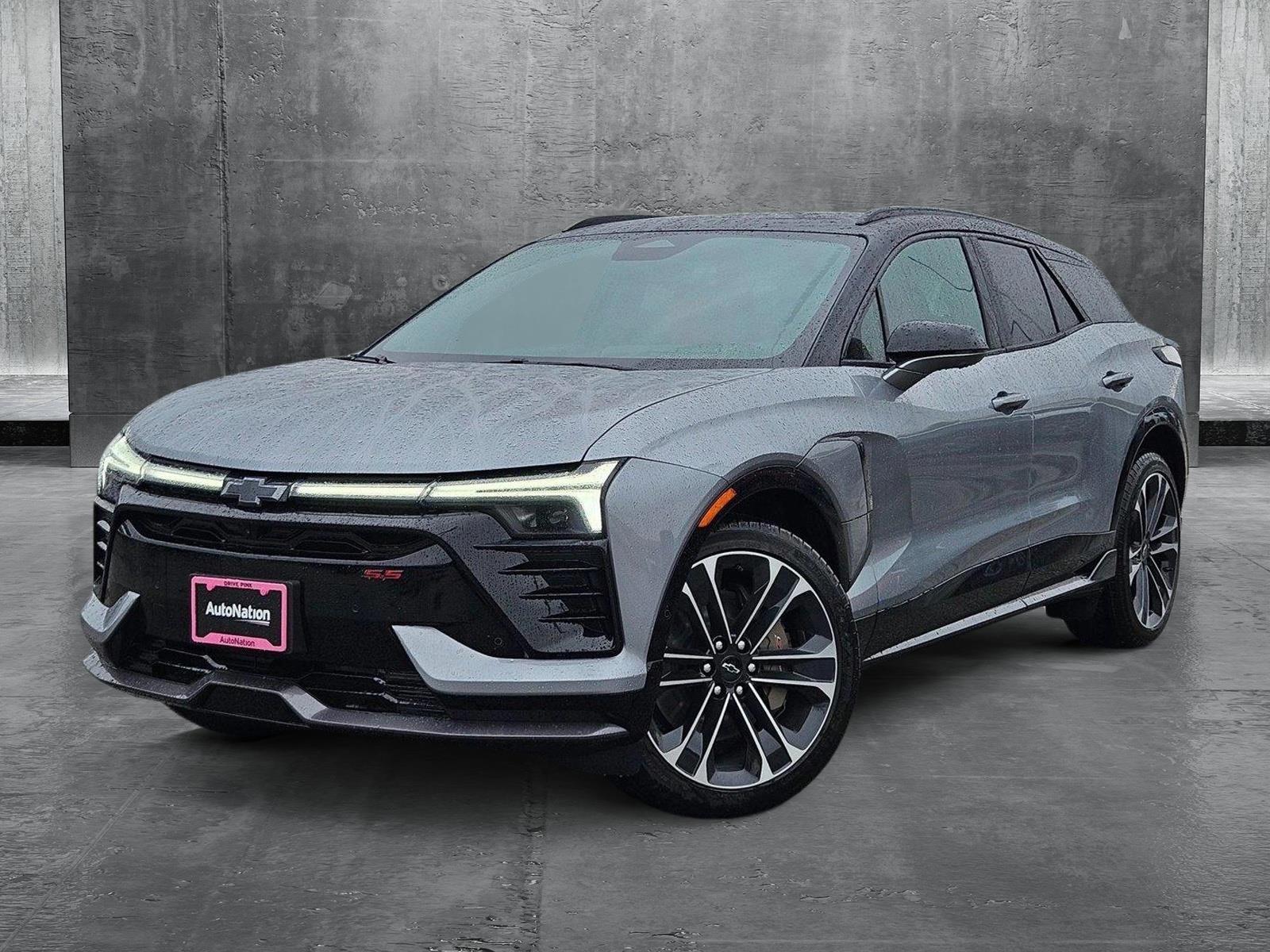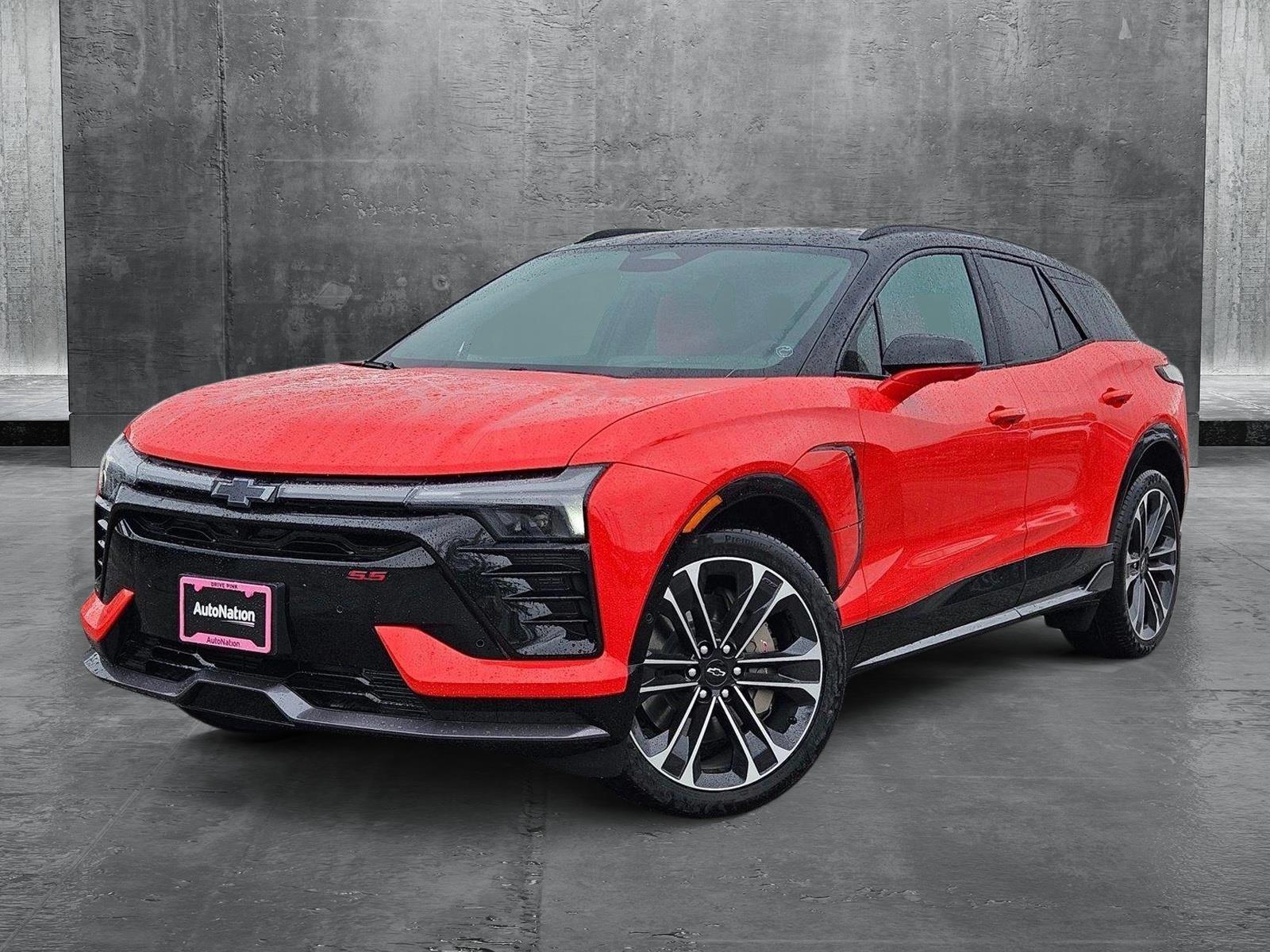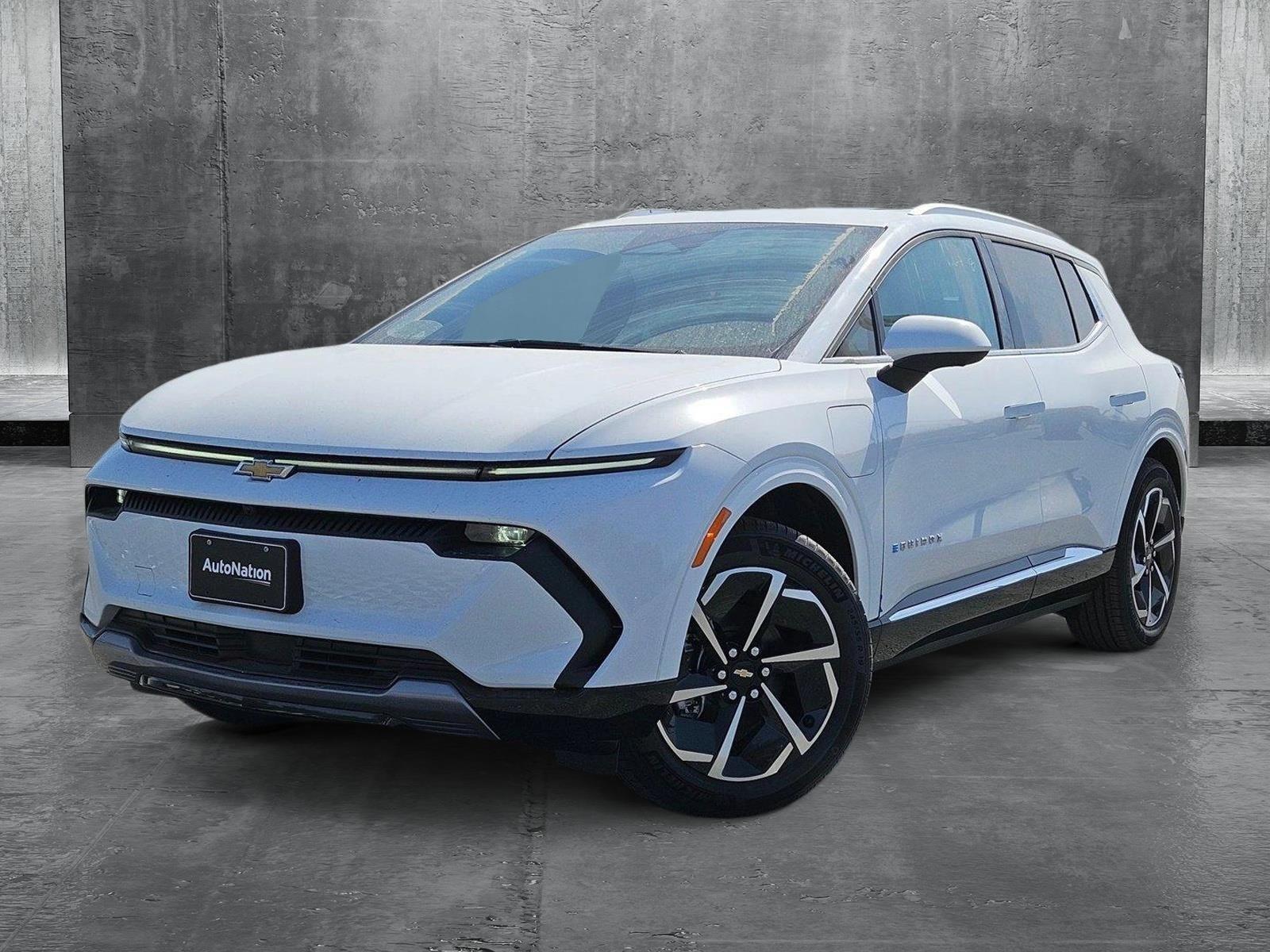AutoNation is Your Electric Vehicle Dealer in AUSTIN
Whether you are looking for an all-electric vehicle (EV) or a plug-in hybrid, you'll find Chevrolet electric cars for sale in AUSTIN at AutoNation Chevrolet Austin near Round Rock and West Lake Hills.
Shop the current selection of new and used electric cars, hybrids and plugin-hybrids for sale AutoNation Chevrolet Austin, or learn more about Chevrolet electric vehicles and contact us for any questions about this exciting new era in the world of automotive.
Shop the current selection of new and used electric cars, hybrids and plugin-hybrids for sale AutoNation Chevrolet Austin, or learn more about Chevrolet electric vehicles and contact us for any questions about this exciting new era in the world of automotive.
Silverado EV
The Chevrolet Silverado EV is a reimagined full-size, fully-electric pickup, developed from the ground up, leveraging the power of GM’s Ultium EV platform. As an all-electric version of the popular Silverado, it offers a revolutionary mix of performance, capability, technology, and style, including an expected GM-estimated range of 400 miles on a full charge, standard DC fast charging, up to 10.2kW of offboard power and up to 10,000 pounds of maximum trailering. It is designed to appeal to both work and lifestyle customers, featuring a spacious cabin, innovative storage solutions, and cutting-edge driver assistance systems. The Silverado EV is part of General Motors' broader push towards a sustainable future, utilizing the Ultium platform that underpins GM's next-generation electric vehicles. With its blend of power, efficiency, and modern design, the Silverado EV is set to be a major player in the electric truck market.

Equinox EV
the 2024 Chevrolet Equinox EV is very different from the regular Equinox. Instead of running on gasoline, it uses electric power. The base model has front-wheel drive with one electric motor that produces 213 horsepower. You can also get an all-wheel-drive version with two motors, boosting the power to 288 horsepower. The front-wheel-drive version can go up to 319 miles on a full charge, while the all-wheel-drive version goes up to 285 miles.
The Equinox EV has a cool mix of futuristic and traditional SUV designs. It comes with many features, like GM's Super Cruise hands-free driving system. However, the inside isn't as roomy as you might expect. The Equinox EV is priced attractively, making it a good choice for people thinking about switching from a gasoline SUV to an electric one.
The Equinox EV has a cool mix of futuristic and traditional SUV designs. It comes with many features, like GM's Super Cruise hands-free driving system. However, the inside isn't as roomy as you might expect. The Equinox EV is priced attractively, making it a good choice for people thinking about switching from a gasoline SUV to an electric one.
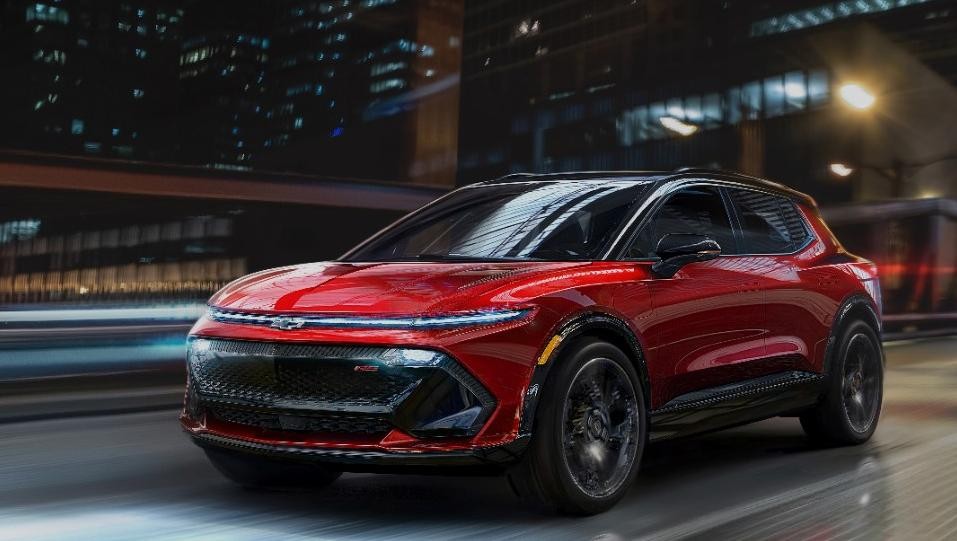
Blazer EV
The 2025 Chevrolet Blazer EV has a lot going for it. It looks great, has two roomy rows of seats, drives confidently, and offers a good driving range. The rear-wheel-drive RS model can go up to 324 miles on a full charge, which is impressive for an EV. If you choose all-wheel drive or one of the LT trims, the range drops below 300 miles. Performance is solid: the all-wheel-drive RS can go from 0 to 60 mph in 6.0 seconds. But if you love speed, the SS model is the best choice with 557 horsepower, reaching 60 mph in about four seconds, according to Chevy.
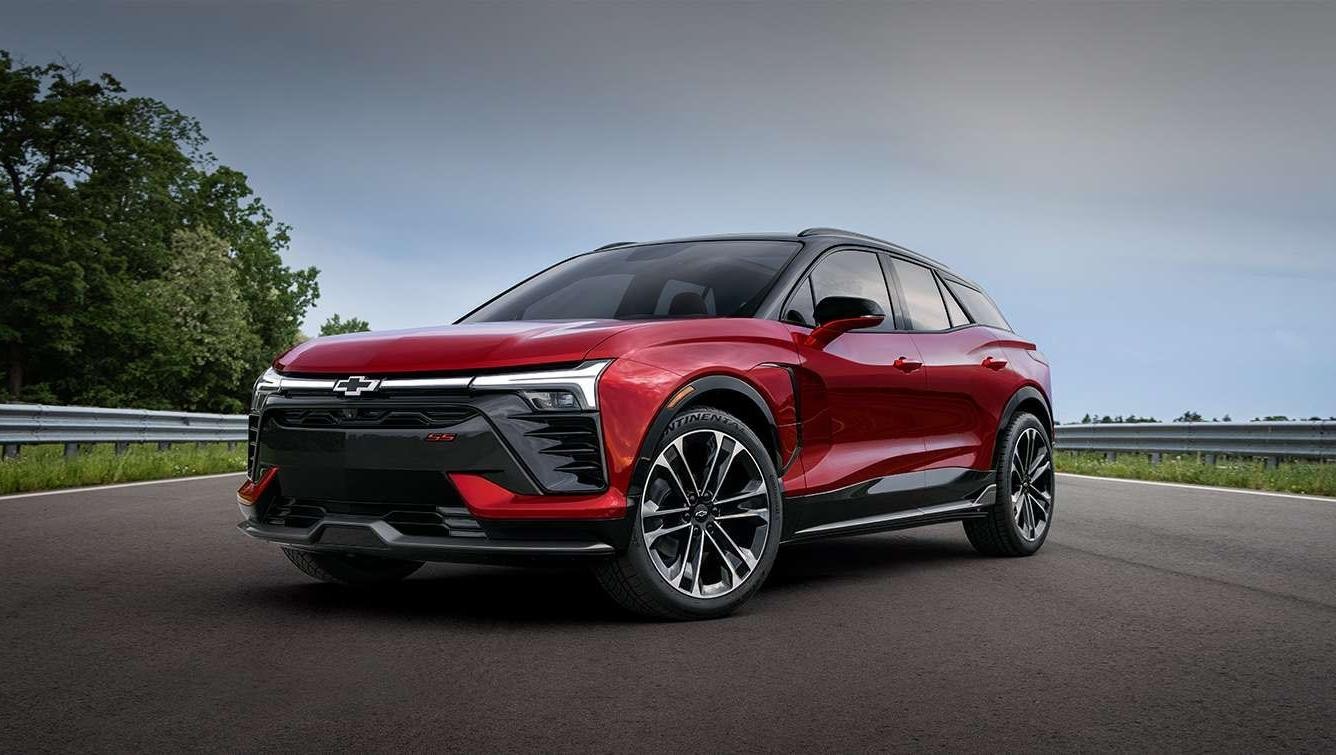
What is an Electric Car?
A modern electric car is a sleek, technologically advanced vehicle powered entirely by electricity. Unlike traditional gasoline-powered cars, electric cars use batteries to store energy and electric motors to drive the wheels. This design offers a quiet and smooth driving experience, with instant torque for quick acceleration. Modern electric cars come equipped with various smart features, such as advanced driver-assistance systems, large touchscreens, and over-the-air software updates. They also typically have regenerative braking systems that help recharge the battery while driving. With increasing ranges—some models offering over 300 miles on a single charge—electric cars are becoming more practical for everyday use. They are also eco-friendly, producing zero emissions and contributing to a cleaner environment.
EV Battery Technology
A key component to the success of any electric vehicle, including those made by Chevrolet, is its battery capabilities. Liquid lithium-ion batteries are a commonly preferred battery technology found in many electric vehicles, including models like the Chevrolet Bolt EV and the upcoming Chevrolet Equinox EV. In these batteries, lithium ions move from the negative electrode through an electrolyte to the positive electrode during discharge and reverse during charging. Lithium-ion batteries use an intercalated lithium compound at the positive electrode and usually graphite at the negative electrode. Another emerging battery type used in some newer models, such as the higher-end variants of Chevy's future lineup, is solid-state batteries. These batteries use thin layers of solid electrolytes to transfer lithium ions between the negative and positive electrodes. However, solid-state batteries are much more expensive to produce—up to eight times more—and are challenging to manufacture at scale, making them more suitable for luxury electric vehicles.
Battery technology is rapidly improving, with advances aimed at increasing energy density, reducing charging times, and lowering costs. For example, some companies are developing silicon anode batteries, which can potentially offer higher energy storage capacity than traditional graphite anodes. Additionally, manufacturers like Tesla and others are exploring new battery chemistries, such as lithium iron phosphate (LFP), which offers greater safety and longer life cycles. These advancements are helping make electric vehicles more efficient, affordable, and accessible to a wider range of consumers.
Battery technology is rapidly improving, with advances aimed at increasing energy density, reducing charging times, and lowering costs. For example, some companies are developing silicon anode batteries, which can potentially offer higher energy storage capacity than traditional graphite anodes. Additionally, manufacturers like Tesla and others are exploring new battery chemistries, such as lithium iron phosphate (LFP), which offers greater safety and longer life cycles. These advancements are helping make electric vehicles more efficient, affordable, and accessible to a wider range of consumers.
The Different Kinds of EVs
Electric vehicles (EVs) come in three main types: full electric vehicles (also known as battery electric vehicles or BEVs), hybrid vehicles (HEVs), and plug-in hybrid vehicles (PHEVs). Each type has its unique characteristics and benefits, catering to different driving needs and preferences.
Full electric vehicles (BEVs) run entirely on electricity, with no internal combustion engine. They rely on a large battery pack to power an electric motor, which drives the wheels. BEVs are known for their zero emissions, making them an environmentally friendly option. They offer a quiet, smooth ride and often feature advanced technology and connectivity. The range of BEVs varies depending on the model and battery capacity, with some newer models offering over 300 miles on a single charge. Charging can be done at home, at work, or at public charging stations, and with advancements in fast-charging technology, it's becoming more convenient to keep them powered up.
Hybrid vehicles (HEVs) combine a gasoline engine with an electric motor and a smaller battery. The electric motor assists the gasoline engine during acceleration and can also power the vehicle at low speeds, improving fuel efficiency and reducing emissions. The battery is recharged through regenerative braking and the internal combustion engine, meaning HEVs don't require external charging. Hybrids are a good choice for those looking to improve fuel economy without relying solely on electric power.
Plug-in hybrid vehicles (PHEVs) offer a middle ground between BEVs and HEVs. PHEVs have both an electric motor and a gasoline engine, but they come with a larger battery than standard hybrids, allowing them to operate solely on electric power for a limited range—usually between 20 to 50 miles, depending on the model. After the electric range is depleted, the gasoline engine takes over, making PHEVs versatile for both short trips and longer journeys. They can be plugged in to charge the battery, offering the convenience of driving on electricity while still having the backup of a gasoline engine for extended range. This flexibility makes PHEVs an attractive option for drivers who want to reduce their carbon footprint without worrying about range limitations.
Full electric vehicles (BEVs) run entirely on electricity, with no internal combustion engine. They rely on a large battery pack to power an electric motor, which drives the wheels. BEVs are known for their zero emissions, making them an environmentally friendly option. They offer a quiet, smooth ride and often feature advanced technology and connectivity. The range of BEVs varies depending on the model and battery capacity, with some newer models offering over 300 miles on a single charge. Charging can be done at home, at work, or at public charging stations, and with advancements in fast-charging technology, it's becoming more convenient to keep them powered up.
Hybrid vehicles (HEVs) combine a gasoline engine with an electric motor and a smaller battery. The electric motor assists the gasoline engine during acceleration and can also power the vehicle at low speeds, improving fuel efficiency and reducing emissions. The battery is recharged through regenerative braking and the internal combustion engine, meaning HEVs don't require external charging. Hybrids are a good choice for those looking to improve fuel economy without relying solely on electric power.
Plug-in hybrid vehicles (PHEVs) offer a middle ground between BEVs and HEVs. PHEVs have both an electric motor and a gasoline engine, but they come with a larger battery than standard hybrids, allowing them to operate solely on electric power for a limited range—usually between 20 to 50 miles, depending on the model. After the electric range is depleted, the gasoline engine takes over, making PHEVs versatile for both short trips and longer journeys. They can be plugged in to charge the battery, offering the convenience of driving on electricity while still having the backup of a gasoline engine for extended range. This flexibility makes PHEVs an attractive option for drivers who want to reduce their carbon footprint without worrying about range limitations.
Electric vs. Plug-in Hybrid
Plug-in hybrid
- Primary propulsion: electric motor, supplementary gas motor
- Fuel: Electric battery, backup gas fuel tank available
- Range: Battery range + gas fuel tank
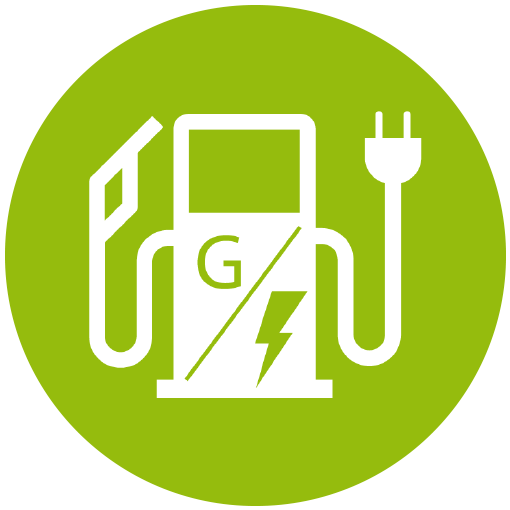
Electric Cars
Electric Cars
- Primary propulsion: electric motor
- Fuel: Electric battery
- Range: Battery range
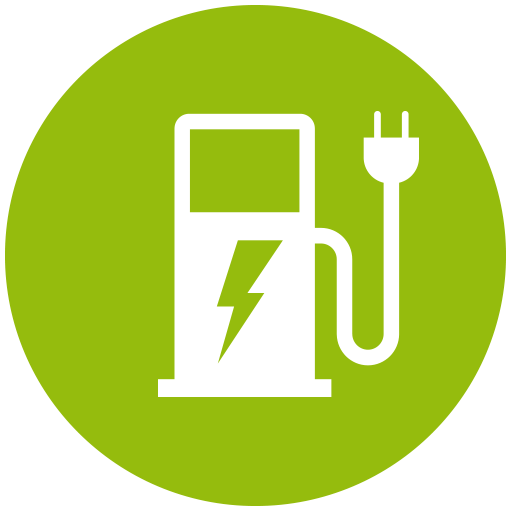
Standard hybrid
Standard hybrid
- Primary propulsion: electric motor, supplementary electric motor
- Fuel: Gas, supplementary passive-charging battery
- Range: Gas fuel tank range

Find a Charger Near You
Use the map below to find a charger near you. The map is powered by ChargeHub and is constantly being updated with all the latest charging networks.
Electric Vehicle Frequently Asked Questions
One of the many benefits of owning an all-electric vehicle (EV) is that you'll never need to visit a gas station. And charging it is as simple as plugging in a power cord, just like any other household electronic device. But since electric vehicles are essentially a complex, self-contained power plant, there's value in understanding the various aspects that affect charging performance, battery health, and cost of ownership. Keep reading for answers to some of the most commonly asked questions regarding the charging and regular maintenance of an all-electric vehicle.
What Are the Basics of Charging an Electric Vehicle?
Every electric vehicle can be charged by plugging in the appropriate cable into any household power outlet. This method is called Level 1 charging, and is accomplished with the power cord that's included as part of the lease or purchase of the electric vehicle.
This is the most convenient form of charging because all you need is access to a standard electrical outlet found in the garage or on the outside of your home - there's no setup or modifications required. But since the battery capacity of an electric vehicle is quite large, and household electrical systems aren't industrial strength by nature, Level 1 charging is the slowest method of replenishing power.
What Is Level 2 Charging?
Waiting nearly two days to charge your vehicle is obviously not ideal, which is why all electric vehicles offer a faster charging speed obtained via Level 2 charging. This higher power delivery is most commonly found in commercial parking lots in malls or shopping centers, and also designated EV parking spaces in office complexes. Some Level 2 charging stations are offered as complimentary perks, but others may require a paid subscription or one-time payment to activate charging - the electricity you're using isn't free after all. Level 2 charging significantly speeds up the process, with many electric vehicles reaching an optimal operating range after about 4 to 8 hours of being plugged in. Keep in mind that the power delivered by Level 2 charging stations can vary, and ultimately, your vehicle is in control of how quickly it can charge.
The speed and convenience of Level 2 charging can be had in your home too, but it may require professional installation of charging equipment, and possibly modification of your home's electrical panel if there isn't enough capacity.
What Is Quick Charging?
"Quick Charging" or Level 3 charging is the fastest form of recharging available today, and can only be found at dedicated stations which require a subscription or payment. But the benefits are well worth the cost, especially if you're taking a long road trip or forgot to charge your vehicle the day before.
Today's newest electric vehicles are really able to take advantage of Level 3 charging. When connected to a 350 kW DC fast charger, your electric vehicle will charge the fastest!
Where Are Charging Stations Located?
With electric vehicles becoming more popular, charging stations are easier to find than ever, especially if you live in a large metropolitan area. Many major malls, grocery stores, and office buildings have dedicated EV parking spaces with charging stations, and more "EV rest stops" are popping up alongside America's most popular freeways.
EVgo, Electrify America, and ChargePoint are examples of the growing networks of charging stations in the country, and finding specific charging stops is as simple as visiting a website or mobile app. Many EVs will already have these charging locations programmed in the navigation system, and Android Auto or Apple CarPlay will also have this information on-hand.
When Is the Best Time to Charge an Electric Vehicle?
In some ways, EVs are just like your smartphone, in that the best time to charge it is, honestly, whenever you have convenient access to power. This could be when you're at work, shopping for groceries, or simply parked at home for the evening.
Because the element of time is unavoidable with electric charging, I personally like to always top off whenever I can so I don't end up with a low battery and "range anxiety." When charging at home, utilize the EV's built-in scheduling function to automatically charge during non-peak hours to reduce electric bill costs and network load.
What is MPGe?
In the past, the vast majority of vehicles on the road were fueled by gas or diesel. So it made sense to measure efficiency by how many miles a vehicle could travel on a gallon. Hence the familiar MPG on the window sticker.
But when the automotive industry began to pivot toward electric vehicles, the Environmental Protection Agency (EPA) needed a new measurement. MPGe stands for "miles per gallon equivalent." In creating the MPGe standard, the EPA based it around the fact that the energy in a gallon of gasoline was equivalent to 33.7 kilowatt-hours (kWh).
What Are the Basics of Charging an Electric Vehicle?
Every electric vehicle can be charged by plugging in the appropriate cable into any household power outlet. This method is called Level 1 charging, and is accomplished with the power cord that's included as part of the lease or purchase of the electric vehicle.
This is the most convenient form of charging because all you need is access to a standard electrical outlet found in the garage or on the outside of your home - there's no setup or modifications required. But since the battery capacity of an electric vehicle is quite large, and household electrical systems aren't industrial strength by nature, Level 1 charging is the slowest method of replenishing power.
What Is Level 2 Charging?
Waiting nearly two days to charge your vehicle is obviously not ideal, which is why all electric vehicles offer a faster charging speed obtained via Level 2 charging. This higher power delivery is most commonly found in commercial parking lots in malls or shopping centers, and also designated EV parking spaces in office complexes. Some Level 2 charging stations are offered as complimentary perks, but others may require a paid subscription or one-time payment to activate charging - the electricity you're using isn't free after all. Level 2 charging significantly speeds up the process, with many electric vehicles reaching an optimal operating range after about 4 to 8 hours of being plugged in. Keep in mind that the power delivered by Level 2 charging stations can vary, and ultimately, your vehicle is in control of how quickly it can charge.
The speed and convenience of Level 2 charging can be had in your home too, but it may require professional installation of charging equipment, and possibly modification of your home's electrical panel if there isn't enough capacity.
What Is Quick Charging?
"Quick Charging" or Level 3 charging is the fastest form of recharging available today, and can only be found at dedicated stations which require a subscription or payment. But the benefits are well worth the cost, especially if you're taking a long road trip or forgot to charge your vehicle the day before.
Today's newest electric vehicles are really able to take advantage of Level 3 charging. When connected to a 350 kW DC fast charger, your electric vehicle will charge the fastest!
Where Are Charging Stations Located?
With electric vehicles becoming more popular, charging stations are easier to find than ever, especially if you live in a large metropolitan area. Many major malls, grocery stores, and office buildings have dedicated EV parking spaces with charging stations, and more "EV rest stops" are popping up alongside America's most popular freeways.
EVgo, Electrify America, and ChargePoint are examples of the growing networks of charging stations in the country, and finding specific charging stops is as simple as visiting a website or mobile app. Many EVs will already have these charging locations programmed in the navigation system, and Android Auto or Apple CarPlay will also have this information on-hand.
When Is the Best Time to Charge an Electric Vehicle?
In some ways, EVs are just like your smartphone, in that the best time to charge it is, honestly, whenever you have convenient access to power. This could be when you're at work, shopping for groceries, or simply parked at home for the evening.
Because the element of time is unavoidable with electric charging, I personally like to always top off whenever I can so I don't end up with a low battery and "range anxiety." When charging at home, utilize the EV's built-in scheduling function to automatically charge during non-peak hours to reduce electric bill costs and network load.
What is MPGe?
In the past, the vast majority of vehicles on the road were fueled by gas or diesel. So it made sense to measure efficiency by how many miles a vehicle could travel on a gallon. Hence the familiar MPG on the window sticker.
But when the automotive industry began to pivot toward electric vehicles, the Environmental Protection Agency (EPA) needed a new measurement. MPGe stands for "miles per gallon equivalent." In creating the MPGe standard, the EPA based it around the fact that the energy in a gallon of gasoline was equivalent to 33.7 kilowatt-hours (kWh).
Electric Vehicles For Sale
New 2024 Chevrolet Blazer EV RS eAWD 3GNKDCRJ6RS232948 Chevrolet
- AutoNation Price $48,981
- Exterior
- Sterling Gray Metallic
- Engine
- ELECTRIC
- Mileage
- 10
New 2024 Chevrolet Blazer EV RS eAWD 3GNKDCRJ2RS223485 Chevrolet
- AutoNation Price $51,482
- Exterior
- Iridescent Pearl Tricoat
- Engine
- ELECTRIC
- Mileage
- 11
New 2024 Chevrolet Blazer EV RS RWD 3GNKDHRK1RS261683 Chevrolet
- AutoNation Price $50,981
- Exterior
- Summit White
- Engine
- ELECTRIC
- Mileage
- 10
New 2024 Chevrolet Blazer EV RS eAWD 3GNKDCRJXRS284907 Chevrolet
- AutoNation Price $49,981
- Exterior
- Summit White
- Engine
- ELECTRIC
- Mileage
- 10
Demo Special Value (New) 2024 Chevrolet Blazer EV LT eAWD 3GNKDBRJ1RS250672 Chevrolet
- AutoNation Price $44,998
- Exterior
- Iridescent Pearl Tricoat
- Engine
- ELECTRIC
- Mileage
- 6,305
New 2024 Chevrolet Silverado EV e4WD Crew Cab Work Truck w/3WT 1GC10UED4RU204927 Chevrolet
- AutoNation Price $60,941
- Exterior
- Summit White
- Engine
- ELECTRIC
- Mileage
- 10
Demo Special Value (New) 2024 Chevrolet Blazer EV RS RWD 3GNKDHRK6RS261694 Chevrolet
- AutoNation Price $49,481
- Exterior
- Riptide Blue Metallic
- Engine
- ELECTRIC
- Mileage
- 11
New 2024 Chevrolet Silverado EV e4WD Crew Cab Work Truck w/3WT 1GC10UED8RU204929 Chevrolet
- AutoNation Price $62,490
- Exterior
- Summit White
- Engine
- ELECTRIC
- Mileage
- 10
New 2025 Chevrolet Blazer EV LT FWD 3GNKDBRM1SS192692 Chevrolet
- AutoNation Price $47,480
- Exterior
- Radiant Red Tintcoat
- Engine
- ELECTRIC
- Mileage
- 7
New 2025 Chevrolet Blazer EV LT FWD 3GNKDBRM6SS191733 Chevrolet
- AutoNation Price $47,480
- Exterior
- Summit White
- Engine
- ELECTRIC
- Mileage
- 7
New 2025 Chevrolet Blazer EV SS AWD 3GNKDERL8SS192438 Chevrolet
- AutoNation Price $62,685
- Exterior
- Black
- Engine
- ELECTRIC
- Mileage
- 7
New 2025 Chevrolet Blazer EV LT FWD 3GNKDBRM8SS192754 Chevrolet
- AutoNation Price $46,985
- Exterior
- Black
- Engine
- ELECTRIC
- Mileage
- 10
New 2025 Chevrolet Blazer EV LT FWD 3GNKDBRM9SS192911 Chevrolet
- AutoNation Price $43,995
- Exterior
- Sterling Gray Metallic
- Engine
- ELECTRIC
- Mileage
- 10
New 2025 Chevrolet Blazer EV SS AWD 3GNKDERL5SS193434 Chevrolet
- AutoNation Price $62,685
- Exterior
- Sterling Gray Metallic
- Engine
- ELECTRIC
- Mileage
- 7
New 2025 Chevrolet Blazer EV SS AWD 3GNKDERL4SS193487 Chevrolet
- AutoNation Price $63,680
- Exterior
- Iridescent Pearl Tricoat
- Engine
- ELECTRIC
- Mileage
- 10
New 2024 Chevrolet Silverado EV e4WD Crew Cab RST 1GC40ZELXRU300062 Chevrolet
- AutoNation Price $89,619
- Exterior
- Black
- Engine
- ELECTRIC
- Mileage
- 10
New 2025 Chevrolet Blazer EV SS AWD 3GNKDERL0SS195625 Chevrolet
- AutoNation Price $63,680
- Exterior
- Iridescent Pearl Tricoat
- Engine
- ELECTRIC
- Mileage
- 7
New 2025 Chevrolet Blazer EV SS AWD 3GNKDERL9SS195641 Chevrolet
- AutoNation Price $62,685
- Exterior
- Riptide Blue Metallic
- Engine
- ELECTRIC
- Mileage
- 7
New 2024 Chevrolet Silverado EV e4WD Crew Cab RST 1GC40ZEL5RU303841 Chevrolet
- AutoNation Price $87,792
- Exterior
- Summit White
- Engine
- Electric
- Mileage
- 10
New 2025 Chevrolet Blazer EV SS AWD 3GNKDERL8SS199051 Chevrolet
- AutoNation Price $61,995
- Exterior
- Sterling Gray Metallic
- Engine
- ELECTRIC
- Mileage
- 7
New 2025 Chevrolet Blazer EV SS AWD 3GNKDERLXSS199004 Chevrolet
- AutoNation Price $62,685
- Exterior
- Habanero Orange
- Engine
- ELECTRIC
- Mileage
- 7
New 2025 Chevrolet Equinox EV 4dr LT NA *Ltd Avail* 3GN7DLRP1SS194724 Chevrolet
- AutoNation Price $41,990
- Exterior
- Summit White
- Engine
- ELECTRIC
- Mileage
- 6
New 2025 Chevrolet Equinox EV 4dr RS 3GN7DSRP2SS199117 Chevrolet
- AutoNation Price $44,790
- Exterior
- Sterling Gray Metallic
- Engine
- ELECTRIC
- Mileage
- 7
New 2025 Chevrolet Blazer EV LT FWD 3GNKDBRM0SS203973 Chevrolet
- AutoNation Price $45,995
- Exterior
- Summit White
- Engine
- ELECTRIC
- Mileage
- 7



